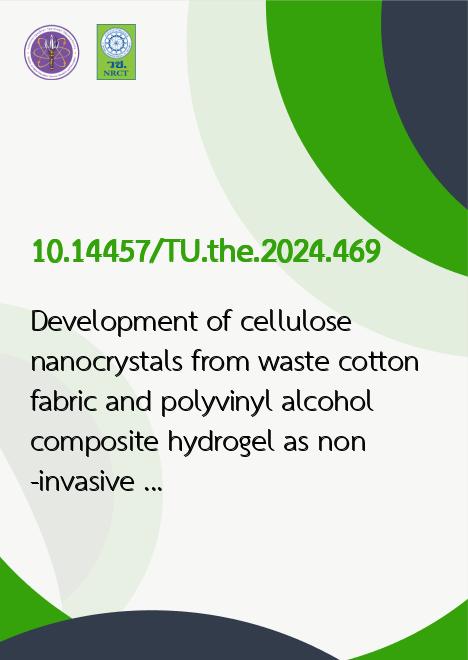
|
Development of cellulose nanocrystals from waste cotton fabric and polyvinyl alcohol composite hydrogel as non-invasive colorimetric sensor for cysteine detection |
|---|---|
| รหัสดีโอไอ | |
| Title | Development of cellulose nanocrystals from waste cotton fabric and polyvinyl alcohol composite hydrogel as non-invasive colorimetric sensor for cysteine detection |
| Creator | Nichakorn Suk-in |
| Contributor | Sarute Ummartyotin, Advisor |
| Publisher | Thammasat University |
| Publication Year | 2567 |
| Keyword | Cotton fabric waste, Cellulose nanocrystals, Polyvinyl alcohol, Hydrogel, Colorimetric sensor, Cysteine, Indicator-displacement assay, PV/Cu2+ complex |
| Abstract | Cellulose nanocrystals (CNCs) extracted and purified from cotton fabric waste serve as a promising reinforcing material for developing hydrogel-based colorimetric sensors. The synthesized CNCs were analyzed using X-ray diffraction spectroscopy (XRD), and Transmission electron microscopy (TEM). Then, the PV/Cu²⁺-CNCs/CNFs/PVA hydrogel was synthesized via chemical crosslinking using borax. With the integration of CNCs, the sensor's sensitivity was notably improved, allowing for a more distinct color change visible to the naked eye. Furthermore, the as-prepared hydrogel was applied as a non-invasive urinary cysteine colorimetric sensor using an indicator-displacement assay (IDA). This sensor exhibits a visible color transition from greenish-blue to orange-red in the presence of cysteine, with a linear range of 0-0.6 g/L and a limit of detection (LOD) of 0.017 g/L, covering cut-off (0.25 g/L) in human urine for monitoring Alzheimer’s disease. Ultimately, this hydrogel-based cysteine sensor was successfully tested in artificial urine samples with acceptable results. Consequently, this platform has a potential for Alzheimer’s disease monitoring in the near future. |